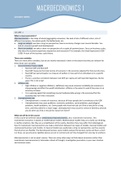Class notes
Macroeconomics 1 lecture notes ALL WEEKS - ENDTERM UVA EBE (Grade: 8)
- Course
- Institution
- Book
This document contains all notes from all the lectures given for this course. Since the lecturer stated that the exam will only include theory explained in the lecure, this is a summary of everything you need to know for the exam! The lecture notes are from the course Macroeconomics 1 (6011P0242Y),...
[Show more]




